Glossary
We have compiled a list of roofing terms for your convenience. We realize that everyone with a slate or copper roof may not be familiar with each element in the roofing system. Hopefully, this list will help our customers to more completely understand their inspection reports and proposals. All pictures used are from work we performed.
Roof boarding and flashing used to create a pitched surface behind a chimney to deflect running water away from the back of the chimney.
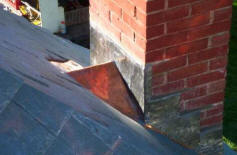
An enlargement or catch basin at the top of a downspout or leader to receive rainwater from a gutter or scupper. (Also called conductor, leader head, leader box, collector, collector head, collector box, scupper head, catch basin, or bell.)

Formed metal secured on or into a wall, chimney or other surface to cover and protect the upper edge of a base flashing and its associated fasteners.
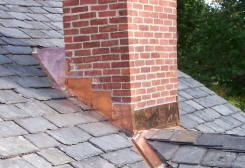
An L-shaped strip of metal placed at the edge of a roof’s eaves to stop the dripping water from wicking beneath the roofing.
A structural separation between two building elements without damage to the roofing or waterproofing system.
A flat horizontal band between moldings.
Sheet metal used to reinforce and weatherproof the joints and angles of a roof.
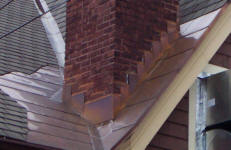
A decorative, often sculptured horizontal band along the upper part of a building or a wall in a room.
The external angle formed by the meeting of two adjacent sloping sides of a roof.
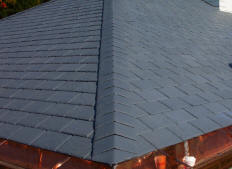
The part of any wall rising entirely above the roof.
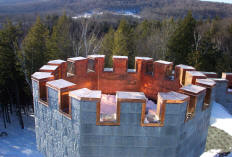
The sloped edge of a roof at the first or last rafter.
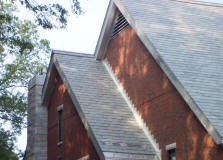
The horizontal line formed by the juncture of two sloping surfaces of a roof.
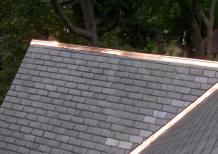
The exposed underside of any component of a building.
A vertical outlet in a roof, usually a pipe, which is covered with flashing to create a watertight opening in the roof.
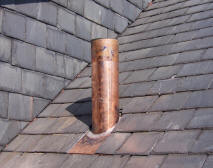
Formed metal laid in each course of slate to shed water from a joint, covered by counter flashing.
Frequently Asked Questions
There are different kinds of slates that have varying life spans. Depending on the type, slate can last from 50 years to over 200 years. Of course, the slate must be maintained and the flashings will have to be replaced periodically.
If your slate roof hasn’t been inspected recently it is a good idea to have it checked. Often, by the time a customer notices a leak, it has already caused major damage. With a small leak, the water may get absorbed by the insulation and interior framing. This can cause rot and mold inside the attic space or walls. The only time some leaks are noticeable are during heavy rain or extended periods of rain. A proper roof inspection can help to eliminate this problem.
An inspection can be performed anytime of the year. If you have not had a recent inspection, the sooner the better. If your roof has been maintained properly it is advisable to have your annual inspection in the spring. At this time we can determine if there was any damage from snow and ice loads on the slate.
Generally the answer to this is no. Roofing companies that do not specialize in slate roofing do not possess the knowledge, or the tools, to properly inspect or work on a slate roof. Someone who is not trained on how to maneuver on slate roofs could cause serious damage to the slates. You should always have a company that is experienced in dealing with all the different aspects of slate perform your inspection or work.
One of the differences between slate and shingle roofs is that the snow does not stick to as well to the slate. It can slide off in large sheets as the roof underneath heats up and causes a small layer of water between the slate and the snow. The effects of sliding snow can range from a minor nuisance to a major liability. If the snow is falling onto areas where people could be located it is very dangerous. To fix this problem, snowguards can be installed. There are different types for different applications. These products will hold the snow on the roof where it can slowly melt and drip harmlessly into the gutters.
Almost every customer wants to know how long the copper will look original. The copper will start to slowly turn brown as early as the first rainfall. The copper then will continue to turn until it reaches a light blue-green color. This patina coating on the copper is actually what protects the copper from atmospheric corrosion. This significantly increases the lifespan of copper roofing and flashing.
Weathering Chart
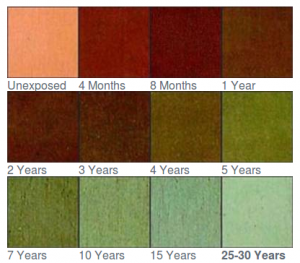
The thickness of the copper and how it is used on the roof will determine how long it will last. Generally, the copper that does not have a lot of water runoff, like hip and ridge caps, will last longer, about 100 years. The copper that has a lot of water run-off, such as a valley, will more likely last around 50 years.
Mahan Slate Roofing Co. can custom fabricate all types of collector boxes. Because we have our own full service sheet metal shop we are able to provide more options to our customers when it comes to copper products and roofing.
